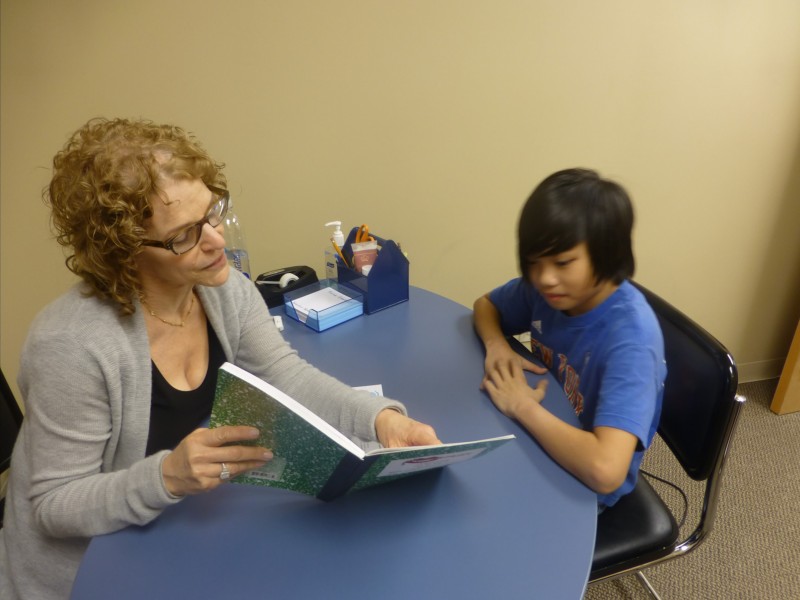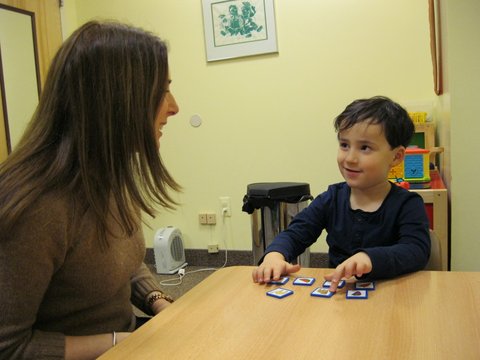Voice and Resonance Disorders
A Voice Disorder is a disturbance of a child’s vocal pitch, intensity, or quality that differs significantly from the voices of his peers. Diagnosis is an essential element in the management of a voice disorder. It is the process of determining the cause or causes and is an ongoing process throughout our treatment. Clinical studies find voice treatment to be a significant factor in improving voice function and in reducing the recurrence of laryngeal pathology.
View our other approaches:
- Apraxia of Speech (CAS)
- Articulation Disorders
- Auditory Processing Disorders (APD)
- Autism Spectrum Disorder (ASD)
- Deviate Swallow (Tongue Thrust)
- Executive Functions Deficits
- Expressive-Receptive Language Delays/Disorders
- Feeding Disorders
- Fluency (Stuttering)
- Oral Motor Disorders
- Phonological Disorders
- Social (Pragmatic) Communication
- Voice and Resonance Disorders
 Our treatment approach to Voice Disorders begins with a diagnosis from an otolaryngologist with a referral for speech therapy. The otolaryngologist remains a key member of our treatment team throughout the therapy process.
Our treatment approach to Voice Disorders begins with a diagnosis from an otolaryngologist with a referral for speech therapy. The otolaryngologist remains a key member of our treatment team throughout the therapy process.
The most common voice disorder treated at Suburban Speech Center is vocal nodules. Vocal nodules are benign whitish protuberances that occur at the junction of the anterior and middle thirds of the vocal folds, the area of maximum impact during vocal fold closure. These calluslike formations prevent complete adduction of the folds and result in a lower pitch and breathy, hoarse voice quality. Common causes of vocal nodules in children include misuse or abuse of the voice including shouting, screaming and excessive talking, as well as excessive coughing or throat clearing.
Research has found that voice therapy should be the first recommendation for treatment of vocal nodules. Our approach to the treatment of voice disorders incorporates components identified by the American Speech-Language-Hearing Association (ASHA).

Auditory-Visual-Tactile Assessment by the speech-language pathologist is the analysis of the voice in terms of pitch, quality and loudness. The child is taught to identify varying degrees of these features with the use of auditory, visual, tactile feedback. Next, the child will learn to discriminate appropriate versus faulty vocal production, culminating in the child’s ability to produce standard vocal quality.
Creating a Hierarchy of situations of identifiable vocal abuse. The hierarchy begins with occasions where the child exhibits the least amount of vocal misuse/abuse to the greatest amount of misuse/abuse. Therapy will help the child, caregivers and teachers to modify his environment to create optimal speaking opportunities.
Improving Breath Support and Control by controlling exhalation with the abdominal muscles and not the throat or shoulders and Reducing Laryngeal Tension by using easy initiation of tone to help reduce the pressure and tension on the vocal cords.
Role Playing is used to simulate typical speaking situations that the child experiences on a daily basis. The speech-language pathologist will help the child create alternative speech behaviors for these circumstances. Role playing is then carried over in the home and school environments.
Vocal Abuse and Misuse charts are a critical component of our voice therapy protocol. These charts provide the child, parents, and teachers with a systematic approach to monitoring and correcting the child’s vocal pattern. The child will list alternative strategies to replace the situations where he misuses/abuses his voice.
A Resonance Disorder refers to the way airflow for speech is shaped as it passes through the oral and nasal cavities when there is an opening, inconsistent movement or obstruction that changes the way the air flows through the system. There are five types of resonance disorders: hypernasality, assimilated nasality, hyponasality (denasality), mixed nasality, and cul de sac.
 Our treatment approach to Resonance Disorders begins with a diagnosis from an otolaryngologist with a referral for speech therapy. The otolaryngologist and/or members of a medical cleft palate team remain key members of our treatment team throughout the therapy process.
Our treatment approach to Resonance Disorders begins with a diagnosis from an otolaryngologist with a referral for speech therapy. The otolaryngologist and/or members of a medical cleft palate team remain key members of our treatment team throughout the therapy process.
The most common resonance disorder treated at Suburban Speech Center is velopharyngeal dysfunction (VPD). Velopharyngeal dysfunction is a disorder in which the soft palate does not make sufficient contact with the posterior and lateral pharyngeal walls, resulting in nasal air emission during high-pressure oral consonant production. Possible causes of velopharyngeal dysfunction include unrepaired or submucous cleft palate, short palate, ineffective pharyngeal flaps, large pharyngeal space resulting from post adenoidectomy, or post maxillary advancement. Our approach to the treatment of resonance disorders incorporates protocols identified by the American Speech-Language-Hearing Association (ASHA) and the American Cleft Palate-Craniofacial Association (ACPA)

Interpersonal Scanning is used to reduce hypo- and hyper-nasality. Improvement of interpersonal scanning skills provides the child with a foundation for determining when a voice quality is acceptable or not acceptable. Scanning techniques are used with feedback through the use of visual and auditory equipment.
Multimodality Training is used to increase the child’s awareness of resonance characteristics via auditory, visual and kinesthetic senses. Auditory discrimination is a key component to help the child identify the components of his resonance pattern. Visual and tactile feedback techniques provide the child with additional information.
Nasal-Oral Pressure techniques are implemented in order to improve velopharyngeal closure and reduce hypernasal quality. The speech-language pathologist will teach the child to achieve correct tongue positioning within the oral cavity. Precise tongue tip and velar contact, as well as firm lip closure and jaw mobility, help the child achieve appropriate resonance. Redirection of the breath stream will help the child reduce hypernasality.
Articulation Production and Refinement techniques are essential for overall articulatory precision. An articulation assessment will be completed to analyze the child’s placement, manner, and production of speech sounds in words and sentences. The tongue position in the oral cavity is a primary factor in determining the quality and resonance of the voice. Inaccurate compensatory articulation posturing will be corrected, as needed.
At Suburban Speech Center, our comprehensive auditory processing treatment approach is individualized to each child’s needs. Home carryover is an integral part of the program. Each child is provided with a speech notebook that contains age appropriate treatment objectives and interactive exercises.
